If you're a homeowner concerned about asbestos, understanding abatement is vital. Start by identifying asbestos-containing materials through thorough inspections and certified testing. Once confirmed, prepare for removal by sealing off work areas and using proper personal protective equipment. During the abatement, employ wet methods to minimize dust and ensure all waste is disposed of correctly in compliance with regulations. After removal, conduct air quality testing to confirm safety and check for residual fibers. Regular follow-ups will help maintain a safe environment. There's much more to consider for effective abatement and safety throughout the process.
Understanding Asbestos Risks
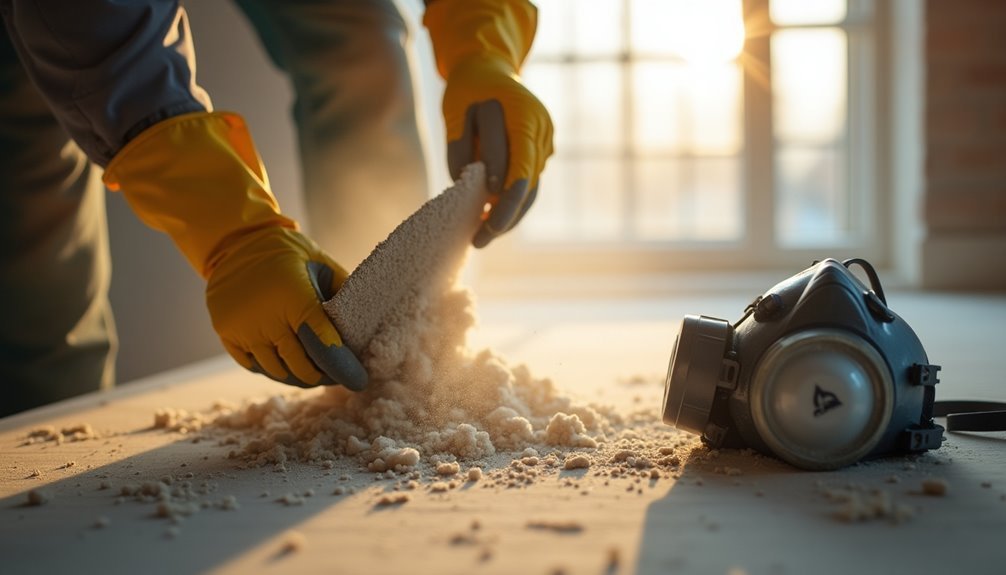
Understanding the risks associated with asbestos exposure is crucial for safeguarding your health and the health of those around you. Asbestos, once celebrated for its fire-resistant properties, has a dark history linked to severe health issues. Health statistics reveal that exposure can lead to various cancers, including lung cancer and mesothelioma, often manifesting decades after initial contact. You might be surprised to learn that even nonmalignant conditions, like pleural thickening and asbestosis, can significantly impair lung function.
Cumulative exposure over long periods intensifies these risks, particularly for smokers, whose likelihood of developing lung cancer skyrockets when combined with asbestos exposure. Secondary exposure affects family members of workers and those living near asbestos mines, making it a community issue. Inhalation of asbestos fibers can lead to asbestosis, a chronic disease, complicating prevention efforts. The latency period for asbestos-related diseases can stretch from 20 to 50 years, complicating prevention efforts. You must stay vigilant, especially during renovations, as disturbing asbestos-containing materials can release harmful fibers. By understanding these risks, you empower yourself to take necessary precautions and advocate for safer living environments, ultimately liberating yourself from the shadow of asbestos-related health threats.
Initial Inspection and Testing
An effective initial inspection and testing process is vital for identifying asbestos-containing materials (ACMs) in your building. Start with a thorough visual inspection to pinpoint areas where ACMs might be present. Create an inventory of suspect materials, including insulation, flooring, and roofing. Ensure you have full access to every room, as limited access might necessitate follow-up visits.
Engage a certified asbestos inspection professional to guarantee compliance with federal, state, and local regulations. They'll adhere to safety precautions, such as wearing gloves and turning off HVAC systems to reduce the risk of asbestos fiber release. Certified inspection is crucial to ensure that all regulations are met during the survey process.
For sampling, implement robust asbestos identification techniques. Select materials suspected of containing asbestos, and use clean, wet sampling tools to gather appropriate volumes. Ensure proper sample handling by placing them in airtight containers labeled with crucial identification data. Multiple samples from each material type are essential due to variability in asbestos distribution.
Finally, transport your samples to a laboratory for analysis, following established sampling protocols. Accurate identification of ACMs is the first step in ensuring a safe environment and making informed decisions about abatement actions.
Preparing for Removal
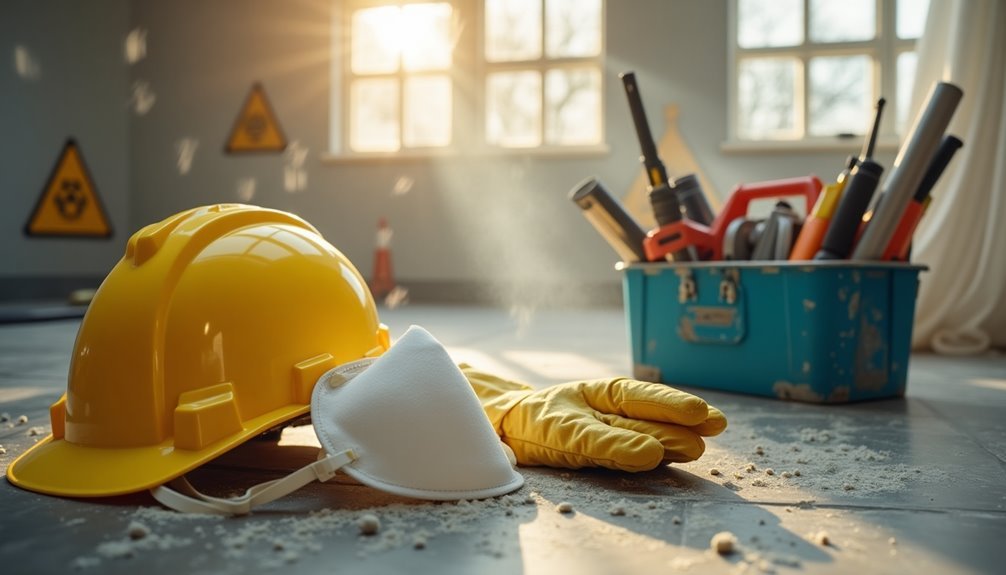
Before you begin asbestos removal, it's crucial to clear the area of all personal belongings and furniture to minimize contamination. Seal off workspaces with plastic sheeting and ensure that your HVAC system is turned off to prevent fiber circulation. These steps are essential for maintaining safety and containment throughout the abatement process.
Clear the Area
Preparing the area for asbestos removal is crucial for ensuring safety and efficiency during the abatement process. To achieve effective area preparation, follow these steps:
| Step | Action |
|---|---|
| Remove Personal Belongings | Clear all furniture, electronics, and items from the work area. Cover items that can't be moved with plastic sheeting. |
| Protect Adjacent Areas | Use plastic sheeting to seal off perimeters, ensuring windows and vents are closed. Set up airlocks for safe worker access. |
| Prepare for Worker Access | Create a designated entry/exit route, equip workers with personal protective gear, and establish a decontamination area. |
Seal Off Workspaces
Once the area is cleared, sealing off workspaces is the next critical step in the asbestos abatement process. Effective workspace preparation is vital to prevent asbestos fibers from escaping into unaffected areas. Use plastic sheeting and duct tape to create a physical barrier around the worksite. Install thick plastic, tape, and portable airlocks to further contain the area, ensuring it's clearly marked as a hazard zone.
Incorporate sealing techniques that include tarps and heavy-duty adhesives for sections not undergoing removal. This minimizes the risk of unintentional exposure. Additionally, specialized air filtration units should be employed to capture airborne asbestos fibers, maintaining negative air pressure within the containment zone. This approach allows airflow to enter the sealed area without allowing contaminated air to circulate back into the building.
HVAC System Precautions
To ensure a safe asbestos removal process, it's essential to take specific precautions with your HVAC system. First, turn off your HVAC systems to prevent asbestos fibers from circulating through the ventilation system. Clear the area around the HVAC unit of personal belongings and furniture to minimize contamination risks. Make sure all occupants, including pets, temporarily relocate during the removal process for their safety.
Before starting, conduct a thorough inspection and testing by a licensed asbestos inspector. They'll provide a written report with abatement recommendations and laboratory analysis of samples. During the removal, consider duct sealing to prevent any potential spread of asbestos fibers through the air ducts.
Sealing the Work Area
Sealing the work area is crucial to prevent the spread of asbestos fibers during abatement. By implementing negative air pressure systems and controlling access, you create a controlled environment that minimizes contamination risks. Understanding these measures ensures both safety and compliance throughout the abatement process.
Importance of Sealing
Effective sealing of the work area is essential for preventing the spread of asbestos contamination during abatement. By employing effective sealing techniques and containment strategies, you can ensure a safer environment throughout the process. Here's a breakdown of the key actions you should take:
| Action | Purpose | Tools/Materials |
|---|---|---|
| Cut Off HVAC Systems | Prevents dirty air circulation | HVAC shutoff |
| Create Physical Barriers | Stops contamination spread | Tarps, polyethylene film |
| Conduct Final Inspection | Confirms containment before abatement | Checklists |
| Maintain Containment Integrity | Ensures barriers remain effective | HEPA vacuums, glove bags |
| Monitor Work Environment | Keeps track of containment status | Regular checks |
Negative Air Pressure
Establishing negative air pressure in the work area is crucial for controlling asbestos fibers and maintaining a safe environment during abatement. To achieve this, you'll need to implement effective negative pressure systems that ensure at least four air changes per hour, or six if you can't reach a negative pressure of -0.02 inches of water column. Each complete air change should occur every ten minutes, promoting good air circulation and minimizing dead air spaces.
Regular air quality monitoring is essential. A recording manometer should be checked every two hours, and you must zero it before beginning work each day. It's also necessary to calibrate this instrument at least once a year to ensure accurate readings. When using negative air machines, exhaust them to the outside to prevent contaminating the indoor environment. If outdoor exhaust isn't feasible, sample air indoors every four hours.
Maintain your system rigorously: document hourly pressure readings in the site log, and address any manometer failures within 24 hours. Critical barriers must be sealed and tested before use to ensure maximum containment of asbestos fibers during the abatement process.
Access Control Measures
To ensure a controlled environment during asbestos abatement, enclosing the work area with plastic sheeting is essential. This barrier effectively isolates the hazardous area, preventing asbestos fibers from escaping into your home. You must seal all openings, including windows and doorways, to maintain this containment. Establishing clear access protocols is crucial; use barricades or fences to define restricted zones where only authorized personnel can enter.
Signage plays a vital role in safety. Post clear warnings at the boundaries, indicating that asbestos work is in progress, along with the associated hazards and precautions for entry. Regularly clean the work area to minimize risk and ensure that no personal belongings or unnecessary items are present. This not only aids safety but also improves efficiency during the abatement process.
Employ drop sheets and barriers to further contain asbestos fibers, and never reuse contaminated materials. Seal off HVAC systems to prevent the circulation of fibers throughout your home. By adhering to these access control measures, you can significantly mitigate the risks associated with asbestos abatement, ensuring both your safety and the integrity of your living environment.
The Removal Process
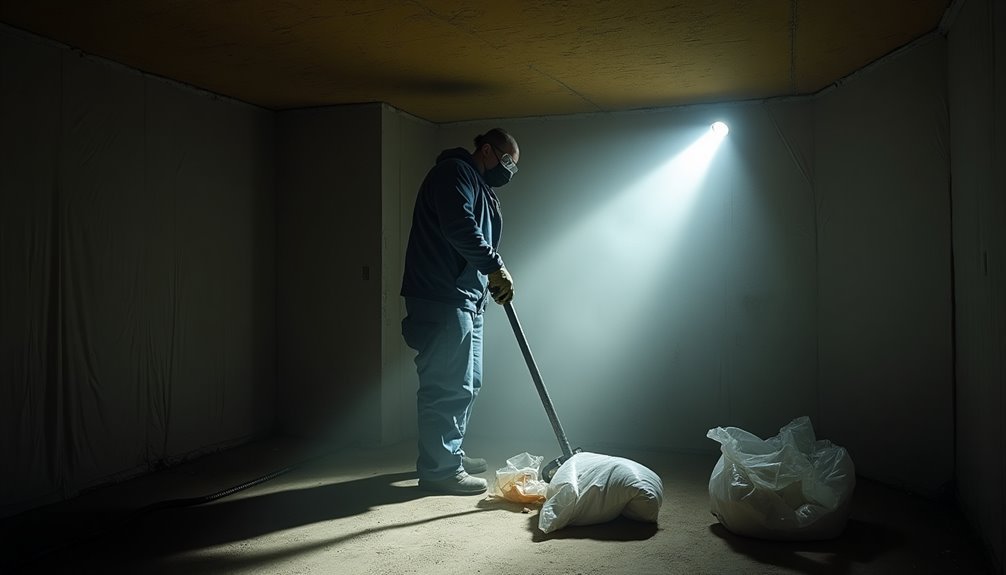
The removal process for asbestos involves meticulous planning and execution to ensure safety and compliance. You need to follow a structured approach that includes several critical steps:
- Preparation: Develop a comprehensive abatement plan that outlines the scope of work and identifies containment measures.
- Containment: Seal off the work area using plastic sheeting and employ negative air pressure machines to prevent fiber spread.
- Removal or Encapsulation: Depending on the situation, decide whether to use asbestos removal techniques or encapsulation methods. Trained workers will utilize specialized tools and wet methods to minimize dust.
- Cleaning and Clearance: After removal, thoroughly clean the area using HEPA vacuums and air scrubbers. Conduct air quality testing to ensure it's safe before dismantling containment.
Safety Precautions
When handling asbestos, your safety is paramount, so you must wear appropriate Personal Protective Equipment (PPE) like a half-face respirator and disposable coveralls. Additionally, implementing effective containment measures is essential to prevent the spread of asbestos fibers during removal. By adhering to these precautions, you significantly reduce the risk of exposure and contamination.
Personal Protective Equipment
Proper use of personal protective equipment (PPE) is crucial for anyone involved in asbestos abatement. You need to ensure that your protective gear is effective in minimizing exposure to dangerous asbestos fibers. Here's what you should focus on:
- Respirators: Use a half-face filter respirator with a class P1 or P2 filter. Make sure it meets Australian Standard AS1716 and achieves a proper respirator fitting—being clean-shaven helps with this.
- Coveralls: Wear disposable coveralls to prevent contamination of your clothing, including shoes. Avoid reusing or shaking out these garments.
- Gloves & Footwear: Opt for single-use gloves and protective footwear like gumboots, which are easy to decontaminate and have no laces or eyelets.
- Eye Protection: Always wear safety goggles or a face shield to guard your eyes against dust and debris.
Remember to keep your respirator on until all work is done and to dispose of contaminated clothing properly. Following these guidelines will help ensure your safety and that of those around you during asbestos abatement.
Containment Measures
Effective containment measures are essential for ensuring safety during asbestos abatement. By implementing sound containment strategies, you minimize the risk of asbestos fibers escaping into the environment. Start by sealing off the work area with heavy-duty plastic sheeting, ensuring it's at least 0.2 mm thick. Use duct tape for effective sealing around edges and install negative air pressure units to contain fibers.
Here's a quick reference table for your containment approach:
| Step | Action | Purpose |
|---|---|---|
| 1. Area Setup | Seal with plastic sheeting | Prevent fiber spread |
| 2. Wet Materials | Use a 1:10 PVA:water solution | Minimize fiber release |
| 3. Isolation | Inform neighbors and close windows | Keep fibers contained |
| 4. Clean-Up | Use HEPA vacuums and wet methods | Remove residual asbestos fibers |
| 5. Waste Disposal | Transport in leak-tight containers | Ensure safe disposal |
Remember to keep all household members and pets away from the work area. Following these guidelines will help ensure a safer environment during and after the abatement process.
Cleaning Procedures
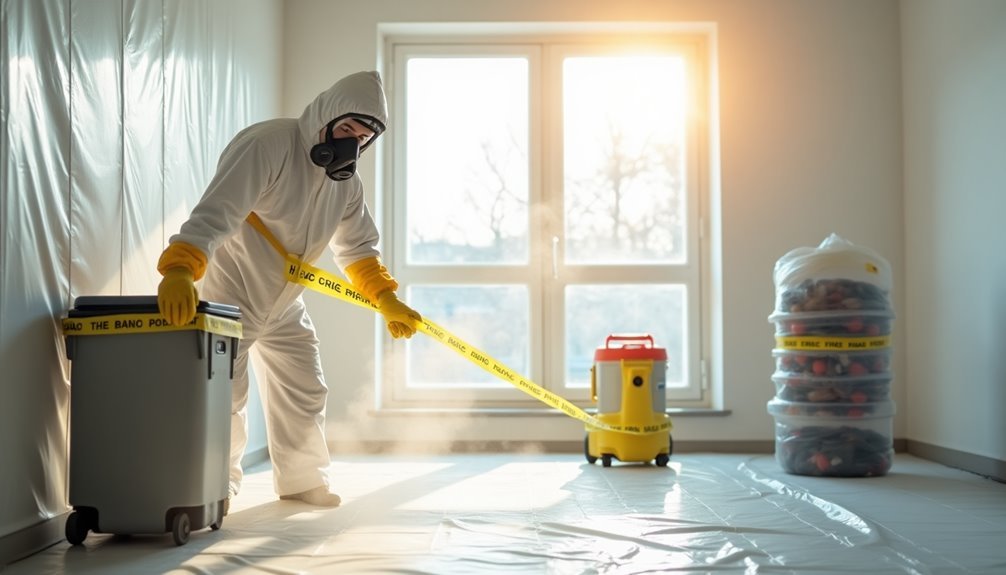
Before initiating the cleaning procedures for asbestos abatement, it's crucial to take the necessary pre-cleanup preparations to minimize risks. By doing this, you'll effectively safeguard yourself and your environment. Follow these essential steps:
- Clear the area of personal belongings and furniture to minimize contamination.
- Seal off work areas with plastic sheeting and use negative air pressure units to prevent fiber spread.
- Turn off HVAC systems to stop asbestos fibers from circulating.
- Inform neighbors and recommend they close doors and windows if working outdoors.
Once preparations are complete, employ effective cleaning techniques to manage any asbestos residue. Use wet mops, rags, sponges, or HEPA vacuum cleaners to thoroughly clean the affected areas. Avoid regular vacuums, which can exacerbate the situation by dispersing fibers. To further control airborne particles, apply a wetting agent to asbestos materials with a hand sprayer.
Finally, dispose of all contaminated materials responsibly in sealed, labeled bags, ensuring compliance with regulations. These thorough cleaning procedures will help you maintain a safe environment, allowing you to reclaim your space with confidence.
Verification and Inspection
Once cleaning procedures are complete, the next step involves verification and inspection to ensure that all asbestos has been properly addressed. You'll need to follow specific verification procedures designed to confirm that the abatement work aligns with established inspection standards. This typically includes a thorough final inspection by a certified asbestos inspector who will evaluate the work area.
During this inspection, the inspector checks for any remaining asbestos materials and verifies that the area has been cleaned effectively. They'll assess whether the containment measures were executed correctly and ensure that no fibers have escaped into the environment. It's crucial that the work area is sealed, and HVAC systems are off, as these factors can significantly impact safety.
After the inspection, you'll receive a certificate of completion, which serves as proof that the abatement process met all regulatory requirements. This documentation is essential for your records and may be required by local authorities. Following these verification procedures not only safeguards your health but also ensures compliance with regulations, paving the way for a safe return to your space.
Proper Waste Disposal
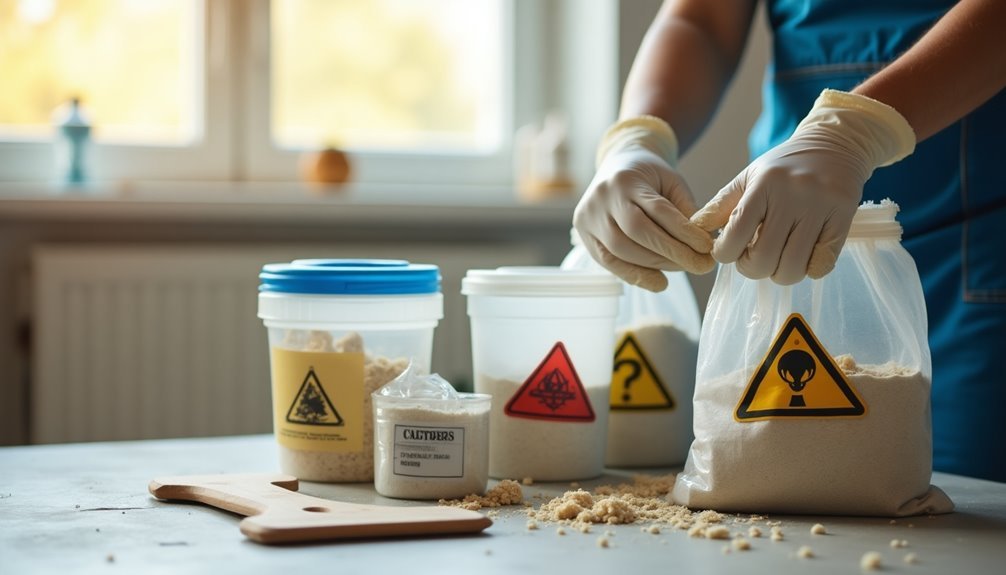
Proper waste disposal is crucial in any asbestos abatement project, as it directly affects both safety and compliance with regulations. Improper handling of asbestos waste can lead to serious health risks and legal issues. To ensure effective waste management, follow these guidelines:
- Seal and Label: All asbestos waste must be sealed in two layers of 6-millimeter plastic bags and labeled with visible warnings about asbestos hazards.
- Use Appropriate Containers: Employ leak-proof, non-returnable containers such as durable plastic bags, cartons, or drums, ensuring they're airtight.
- Transport Safely: Store asbestos waste in a secure area and transport it directly to a licensed landfill, complying with all local, state, and federal disposal regulations.
- Document Everything: Keep thorough records of the disposal process to demonstrate compliance and ensure accountability.
Post-Abatement Considerations
After completing an asbestos abatement project, it's essential to conduct thorough post-abatement considerations to ensure the safety of the environment and occupants. Start with a detailed post-abatement evaluation, which includes a visual inspection of the area to confirm no asbestos fibers were released. Evaluate the type and quantity of asbestos-containing material that was removed, and assess any potential exposure risks, especially if the abatement occurred in high-traffic areas or near air handling systems.
Next, prioritize air quality monitoring by having a certified Air Sampling Technician conduct air sampling. Send samples to an Environmental Laboratory certified by the New York State Department of Health for analysis. Ensure that the testing confirms asbestos levels are within permissible limits.
Don't forget to notify the Department of Environmental Protection and comply with local regulations. If air quality results indicate lingering asbestos fibers, consider additional cleaning or even further abatement. This might involve hiring licensed contractors and employing HEPA vacuums and wet wiping to ensure thorough cleanup. By addressing these post-abatement factors, you contribute to a safer living environment free from asbestos-related risks.
Conclusion
In navigating the complexities of asbestos abatement, think of yourself as a skilled sailor steering through treacherous waters. By understanding the risks, preparing diligently, and following proper procedures, you can safely reach the shore of a healthier home. Remember, thorough cleanup and verification are vital to ensure your environment remains safe long after the removal. With careful planning and execution, you're not just removing a hazard; you're reclaiming peace of mind for you and your family.
